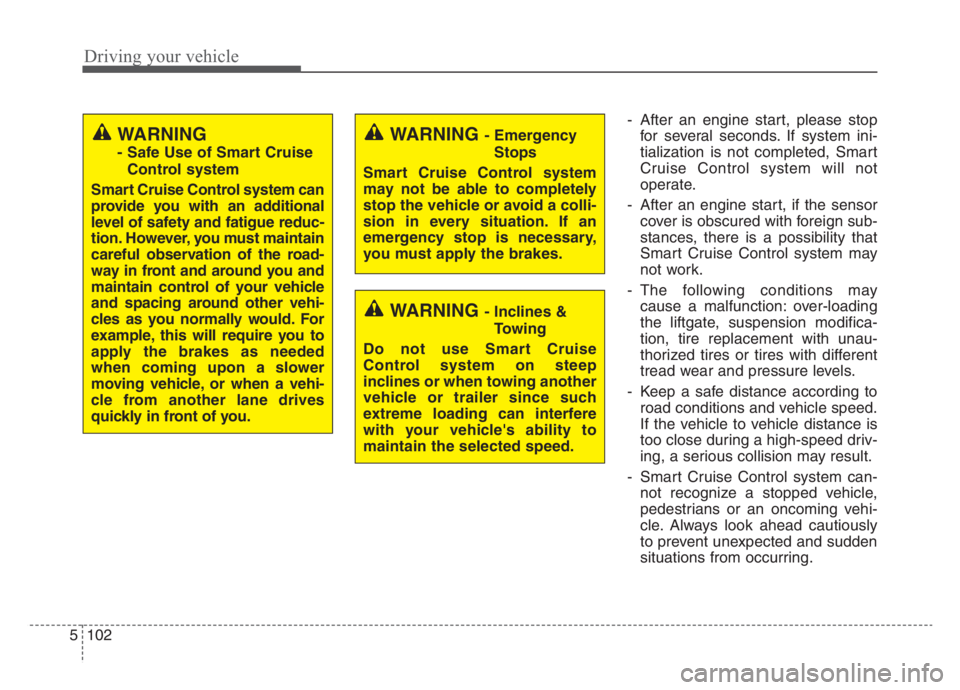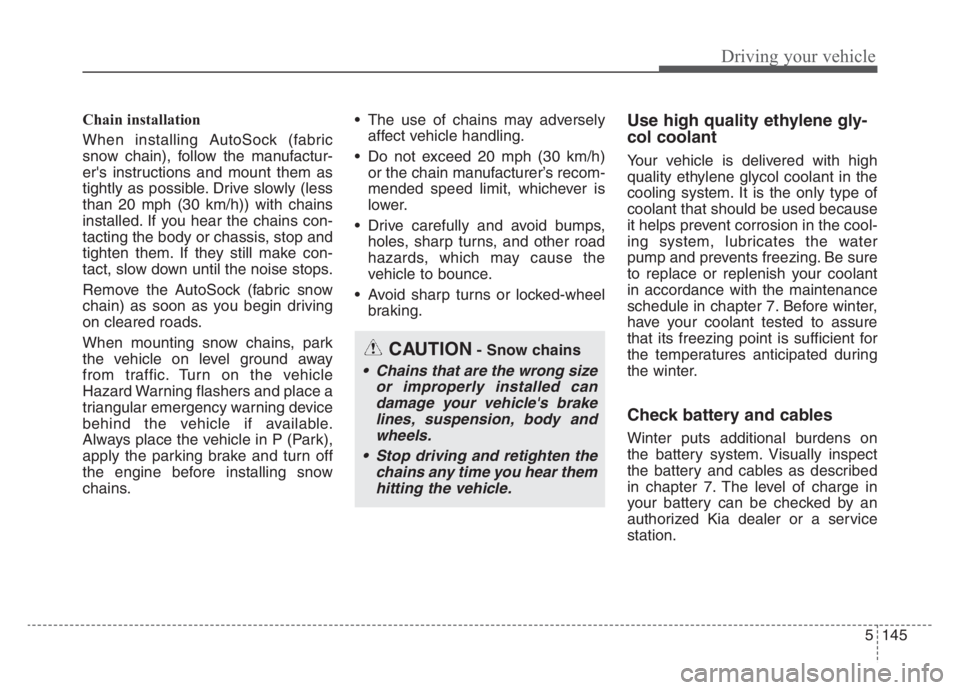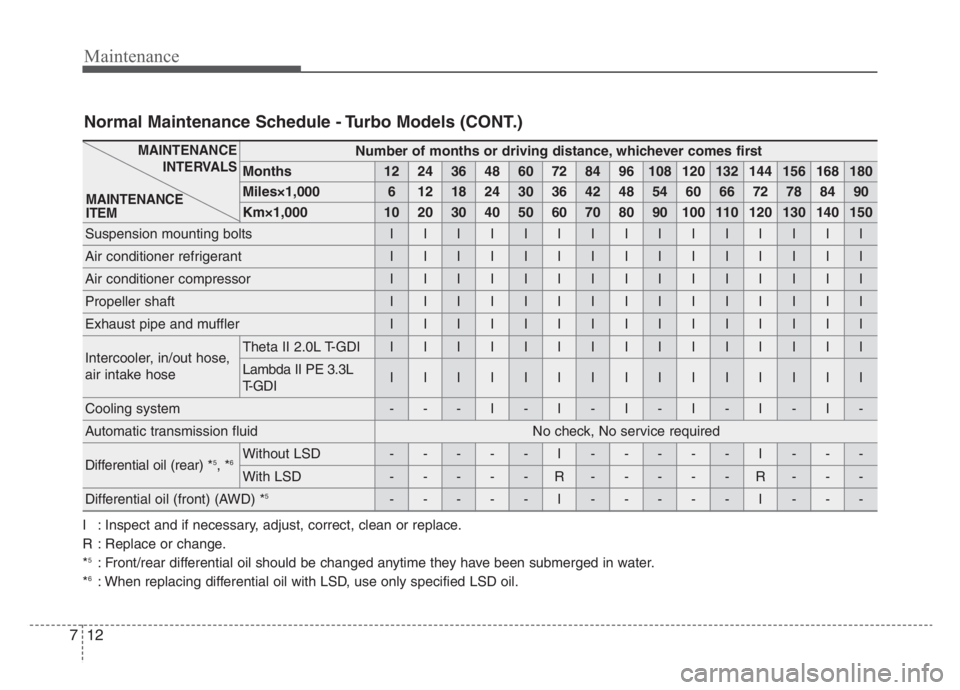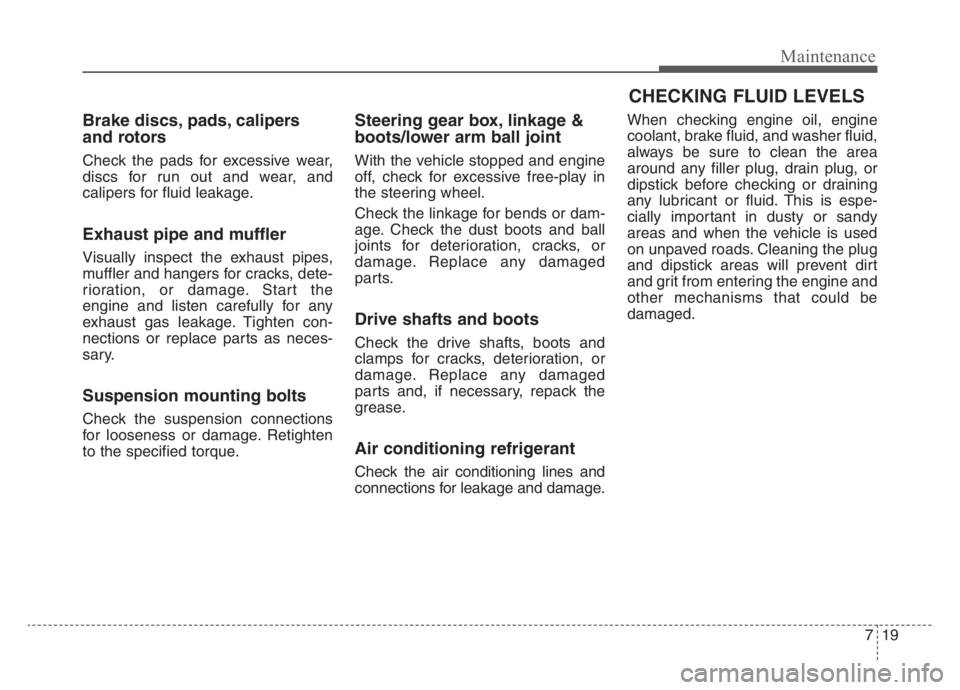suspension KIA STINGER 2021 Owners Manual
[x] Cancel search | Manufacturer: KIA, Model Year: 2021, Model line: STINGER, Model: KIA STINGER 2021Pages: 585, PDF Size: 10.87 MB
Page 188 of 585

499
Features of your vehicle
Forward Collision-
Avoidance Assist
Warning Light (FCA,
if equipped)
This indicator light illuminates:
When there is a malfunction with
FCA.
In this case, have the vehicle inspect-
ed by an authorized Kia dealer.
All Wheel Drive (AWD)
Warning Light
(if equipped)
This indicator light illuminates:
When there is a malfunction with
the AWD system.
In this case, have the vehicle inspect-
ed by an authorized Kia dealer.
Master Warning Light
This indicator light illuminates:
When there is a malfunction on the
pre-safe seat belt, electronic con-
trol suspension, or Smart Cruise
Control with Stop & Go or other
systems etc. To identify the details
of the warning, look at the LCD dis-
play.
Page 363 of 585

Driving your vehicle
102 5
- After an engine start, please stop
for several seconds. If system ini-
tialization is not completed, Smart
Cruise Control system will not
operate.
- After an engine start, if the sensor
cover is obscured with foreign sub-
stances, there is a possibility that
Smart Cruise Control system may
not work.
- The following conditions may
cause a malfunction: over-loading
the liftgate, suspension modifica-
tion, tire replacement with unau-
thorized tires or tires with different
tread wear and pressure levels.
- Keep a safe distance according to
road conditions and vehicle speed.
If the vehicle to vehicle distance is
too close during a high-speed driv-
ing, a serious collision may result.
- Smart Cruise Control system can-
not recognize a stopped vehicle,
pedestrians or an oncoming vehi-
cle. Always look ahead cautiously
to prevent unexpected and sudden
situations from occurring.
WARNING - Inclines &
Towing
Do not use Smart Cruise
Control system on steep
inclines or when towing another
vehicle or trailer since such
extreme loading can interfere
with your vehicle's ability to
maintain the selected speed.
WARNING
- Safe Use of Smart Cruise
Control system
Smart Cruise Control system can
provide you with an additional
level of safety and fatigue reduc-
tion. However, you must maintain
careful observation of the road-
way in front and around you and
maintain control of your vehicle
and spacing around other vehi-
cles as you normally would. For
example, this will require you to
apply the brakes as needed
when coming upon a slower
moving vehicle, or when a vehi-
cle from another lane drives
quickly in front of you.
WARNING - Emergency
Stops
Smart Cruise Control system
may not be able to completely
stop the vehicle or avoid a colli-
sion in every situation. If an
emergency stop is necessary,
you must apply the brakes.
Page 372 of 585

5111
Driving your vehicle
SPORT mode
SPORT mode manages
the driving dynamics by
automatically adjusting
the steering effort, and
the engine and trans-
mission control logic for
enhanced driver per-
formance.
When SPORT mode is selected by
pressing the DRIVE MODE button,
the SPORT indicator (orange
color) will illuminate.
Whenever the engine is restarted,
the Drive Mode will revert back to
COMFORT mode. If SPORT mode
is desired, re-select SPORT mode
from the DRIVE MODE button.
When SPORT mode is activated:
- The engine rpm will tend to
remain raised over a certain
length of time even after releas-
ing the accelerator
- Upshifts are delayed when accel-
erating
✽ ✽
NOTICE
In SPORT mode, the fuel efficiency
may decrease.
CUSTOM mode
CUSTOM mode enables
driver to build their own
customized mode.
Driver can choose
between different
Engine/Transmission,
Steering, Suspension,
AWD, and Active Engine
Sound settings.
To access CUSTOM mode settings
rotate the Drive Mode knob until get-
ting to CUSTOM mode. A Graphic
picture of Kia Stinger will pop up on
main screen with a setting button.
Press the setting button and change
different settings to build your own
mode.
Once the CUSTOM mode settings
are chosen they will be saved and
will remain that way until changed
again in settings.
Whenever the engine is restarted,
the Drive Mode will revert back to
COMFORT mode. If CUSTOM
mode is desired, re-select CUSTOM
mode from the DRIVE MODE but-
ton.
ECO mode
When the Drive Mode is
set to ECO mode, the
engine and transmission
control logic are changed
to maximize fuel efficiency.
When ECO mode is selected by
pressing the DRIVE MODE button,
the ECO indicator (green color) will
illuminate.
If the vehicle is set to ECO mode,
when the engine is turned OFF
and restarted the Drive Mode set-
ting will remain in ECO mode.
✽ ✽
NOTICE
Fuel efficiency depends on the dri-
ver's driving habits and road condi-
tion.
ECOSPORTCUSTOM
Page 405 of 585

Driving your vehicle
144 5
Tire chains
Since the sidewalls on some radial
tires are thinner than other types of
tires, they may be damaged by
mounting certain types of tire chains
on them. Therefore, the use of snow
tires is recommended instead of tire
chains. Do not mount tire chains on
vehicles equipped with aluminum
wheels; if unavoidable, use AutoSock
(fabric snow chain). Install the tire
chain after reviewing the instructions
provided with the tire chains.
Damage to your vehicle caused by
improper tire chain use is not cov-
ered by your vehicle manufacturer’s
warranty.
✽ ✽
NOTICE
• Install AutoSock (fabric snow
chain) on the rear tires for 2WD
vehicles or for AWD vehicles. It
should be noted that installing
AutoSock (fabric snow chain) on the
tires will provide a greater driving
force, but will not prevent side skids.
• Do not install studded tires with-
out first checking local and munic-
ipal regulations for possible
restrictions against their use.
✽ ✽
NOTICE
If you hear noise caused by chains
contacting the body, retighten the
chain to prevent contact with the
vehicle body.
OCK057168
CAUTION
When using AutoSock (fabric
snow chain):
Wrong size chains or improp-
erly installed chains can dam-
age your vehicle's brake lines,
suspension, body and wheels.
To prevent body damage,
retighten the chains after driv-
ing 0.3 ~ 0.6 miles (0.5 ~ 1.0 km).
Page 406 of 585

5145
Driving your vehicle
CAUTION- Snow chains
Chains that are the wrong size
or improperly installed can
damage your vehicle's brake
lines, suspension, body and
wheels.
Stop driving and retighten the
chains any time you hear them
hitting the vehicle.
Chain installation
When installing AutoSock (fabric
snow chain), follow the manufactur-
er's instructions and mount them as
tightly as possible. Drive slowly (less
than 20 mph (30 km/h)) with chains
installed. If you hear the chains con-
tacting the body or chassis, stop and
tighten them. If they still make con-
tact, slow down until the noise stops.
Remove the AutoSock (fabric snow
chain) as soon as you begin driving
on cleared roads.
When mounting snow chains, park
the vehicle on level ground away
from traffic. Turn on the vehicle
Hazard Warning flashers and place a
triangular emergency warning device
behind the vehicle if available.
Always place the vehicle in P (Park),
apply the parking brake and turn off
the engine before installing snow
chains. The use of chains may adversely
affect vehicle handling.
Do not exceed 20 mph (30 km/h)
or the chain manufacturer’s recom-
mended speed limit, whichever is
lower.
Drive carefully and avoid bumps,
holes, sharp turns, and other road
hazards, which may cause the
vehicle to bounce.
Avoid sharp turns or locked-wheel
braking.Use high quality ethylene gly-
col coolant
Your vehicle is delivered with high
quality ethylene glycol coolant in the
cooling system. It is the only type of
coolant that should be used because
it helps prevent corrosion in the cool-
ing system, lubricates the water
pump and prevents freezing. Be sure
to replace or replenish your coolant
in accordance with the maintenance
schedule in chapter 7. Before winter,
have your coolant tested to assure
that its freezing point is sufficient for
the temperatures anticipated during
the winter.
Check battery and cables
Winter puts additional burdens on
the battery system. Visually inspect
the battery and cables as described
in chapter 7. The level of charge in
your battery can be checked by an
authorized Kia dealer or a service
station.
Page 448 of 585

What to do in an emergency
34 6
Ensure any metal parts on the
tiedown straps do not contact
painted surfaces or the face of the
wheels.
Do not place straps over the body
panels or through the wheels.
WARNING - Side and
curtain Air bag
If your vehicle is equipped with
side and curtain air bag, set the
the Engine Start/Stop button to
ACC position when the vehicle
is being towed.
The side and curtain air bag
may deploy when the ignition is
ON, and the rollover sensor
detects the situation as a
rollover.
OCK067024
CAUTION
Attaching straps to the chassis,
suspension or other parts of the
body can cause damage.
OCK067014
OCK067015
CAUTION - Towing
Do not tow the vehicle back-
wards with the rear wheels on
the ground as this may cause
damage to the vehicle.
Do not tow with sling-type
equipment. Use wheel lift or
flatbed equipment.
Page 457 of 585

75
Maintenance
(Continued)
• Wash the undercarriage of your
vehicle regularly during the win-
ter and whenever your vehicle has
been exposed to such salts or
chemicals.
• Do a thorough washing of the
undercarriage at the end of the
winter.
• Use professional service techni-
cians or governmental inspection
stations to annually inspect for
corrosion.
• Immediately seek an inspection of
your vehicle if you become visual-
ly aware of corrosion flaking or
scaling or if you become aware of
a change in vehicle performance,
such as soft or spongy brakes, flu-
ids leaking, impairment of direc-
tional control, suspension noises
or rattling metal straps.
NHTSA further advises that after
a vehicle is 7 years old, it is essen-
tial that you take these indicated
maintenance steps to ensure that
you protect yourself from unsafe
corrosion conditions.Owner maintenance precau-
tions
Improper or incomplete service may
result in problems. This section gives
instructions only for the maintenance
items that are easy to perform.
As explained earlier in this section,
several procedures can be done only
by an authorized Kia dealer with spe-
cial tools.
✽ ✽
NOTICE
Improper owner maintenance dur-
ing the warranty period may affect
warranty coverage. For details, read
the separate Warranty & Consumer
Information manual provided with
the vehicle. If you're unsure about
any servicing or maintenance proce-
dure, have it done by an authorized
Kia dealer.
WARNING- Maintenance
work
Do not wear jewelry or loose
clothing while working under
the hood of your vehicle with
the engine running. These could
become entangled in moving
parts. If you must run the
engine while working under the
hood, make certain that you
remove all jewelry (especially
rings, bracelets, watches, and
necklaces) and all neckties,
scarves, and similar loose
clothing before getting near the
engine or cooling fans.
Page 464 of 585

Maintenance
12 7
Number of months or driving distance, whichever comes first
Months1224364860728496108120132144156168180
Miles×1,00061218243036424854606672788490
Km×1,000102030405060708090100110120130140150
Suspension mounting boltsIIIIIIIIIIIIIII
Air conditioner refrigerantIIIIIIIIIIIIIII
Air conditioner compressorIIIIIIIIIIIIIII
Propeller shaftIIIIIIIIIIIIIII
Exhaust pipe and mufflerIIIIIIIIIIIIIII
Intercooler, in/out hose,
air intake hoseTheta II 2.0L T-GDIIIIIIIIIIIIIIII
Lambda II PE 3.3L
T- G D IIIIIIIIIIIIIIII
Cooling system---I-I-I-I-I-I-
Automatic transmission fluidNo check, No service required
Differential oil (rear) *5, *6Without LSD-----I-----I---
With LSD-----R-----R---
Differential oil (front) (AWD) *5-----I-----I---
MAINTENANCE
INTERVALS
MAINTENANCE
ITEM
Normal Maintenance Schedule - Turbo Models (CONT.)
I : Inspect and if necessary, adjust, correct, clean or replace.
R : Replace or change.
*
5: Front/rear differential oil should be changed anytime they have been submerged in water.
*6: When replacing differential oil with LSD, use only specified LSD oil.
Page 471 of 585

719
Maintenance
Brake discs, pads, calipers
and rotors
Check the pads for excessive wear,
discs for run out and wear, and
calipers for fluid leakage.
Exhaust pipe and muffler
Visually inspect the exhaust pipes,
muffler and hangers for cracks, dete-
rioration, or damage. Start the
engine and listen carefully for any
exhaust gas leakage. Tighten con-
nections or replace parts as neces-
sary.
Suspension mounting bolts
Check the suspension connections
for looseness or damage. Retighten
to the specified torque.
Steering gear box, linkage &
boots/lower arm ball joint
With the vehicle stopped and engine
off, check for excessive free-play in
the steering wheel.
Check the linkage for bends or dam-
age. Check the dust boots and ball
joints for deterioration, cracks, or
damage. Replace any damaged
parts.
Drive shafts and boots
Check the drive shafts, boots and
clamps for cracks, deterioration, or
damage. Replace any damaged
parts and, if necessary, repack the
grease.
Air conditioning refrigerant
Check the air conditioning lines and
connections for leakage and damage.When checking engine oil, engine
coolant, brake fluid, and washer fluid,
always be sure to clean the area
around any filler plug, drain plug, or
dipstick before checking or draining
any lubricant or fluid. This is espe-
cially important in dusty or sandy
areas and when the vehicle is used
on unpaved roads. Cleaning the plug
and dipstick areas will prevent dirt
and grit from entering the engine and
other mechanisms that could be
damaged.
CHECKING FLUID LEVELS
Page 527 of 585

775
Maintenance
Fuse NameFuse ratingCircuit Protected
ECS15AECS (Electronic Control Suspension) Unit
S/HEATER
REAR20ARear Seat Warmer Control Module
HEATED
MIRROR10AAir Conditioner Switch, Driver/Passenger Power Outside Mirror
FUEL PUMP20AFuel Pump Relay
SPARE110A-
SPARE215A-
SPARE315A-
REAR HEATED30ARear Heated Relay
AMP 225AAMP (Amplifier) (MOBIS/PREMIUM)
SPARE415A-
AMP 130ALow DC-DC Converter (AMP (Amplifier))
IG 115AIG1 Relay
ACC30AACC Relay
Rear fuse box panel